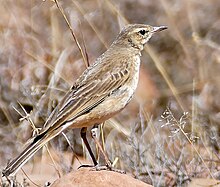Buffy pipit
| Buffy pipit | |
|---|---|

| |
| At Mountain Zebra NP, South Africa | |
| Scientific classification | |
| Domain: | Eukaryota |
| Kingdom: | Animalia |
| Phylum: | Chordata |
| Class: | Aves |
| Order: | Passeriformes |
| Family: | Motacillidae |
| Genus: | Anthus |
| Species: | A. vaalensis
|
| Binomial name | |
| Anthus vaalensis Shelley, 1900
| |
The buffy pipit (Anthus vaalensis) is a species of bird in the
Taxonomy
This species was described by English naturalist
Description
Its length is 16–18 cm (6.3–7.1 in),[4] and its weight is 23–36.6 g (0.81–1.29 oz).[3] It is often confused with the plain-backed pipit because both species have plain upperparts.[5] The upperparts of the buffy pipit are paler and buffier than the plain-backed pipit. The buffy pipit has a pale supercilium, and its lower mandible has a pinkish base.[6] It has faint markings on the breast, and the belly and flanks are buffy. The juvenile has mottles.[4]
Distribution and habitat
The buffy pipit is found in Angola, Botswana, Democratic Republic of the Congo, Eswatini, Malawi, Mozambique, Namibia, South Africa, Tanzania, Zambia, and Zimbabwe, with a distribution size estimated at 5,660,000 km2 (2,190,000 sq mi).[1] Its habitat is semi-arid plains with grasses and bare ground.[6] It also occurs in pastures, burnt fields, and edges of saltpans.[5]
Behaviour
One or two individuals are usually encountered, but flocks may be found in winter.[5] It frequently wags its tail.[6] Its song is a repeated tchreep-churup, and the call sshik is given when the bird is flushed.[4] It eats invertebrates and seeds.[3] Breeding has been recorded from July to February in Zimbabwe and August to December in South Africa.[5] The nest is an open cup built on the ground.[6]
Status
The population size is not known. The species has an increasing population trend and a large range, so the
References
- ^ . Retrieved 17 November 2021.
- ^ Gill, F.; Donsker, D. (eds.). "Waxbills, parrotfinches, munias, whydahs, Olive Warbler, accentors & pipits". IOC World Bird List Version 6.4. Retrieved 17 December 2016.
- ^ a b c Tyler, S. (2016). "Buffy Pipit (Anthus vaalensis)". In del Hoyo, J.; Elliott, A.; Sargatal, J.; Christie, D. A.; de Juana, E. (eds.). Handbook of the Birds of the World Alive.
- ^ ]
- ^ a b c d P. A. Clancey. "Buffy Pipit" (PDF). The Atlas of Southern African Birds.
- ^ ISBN 9781400874170.

